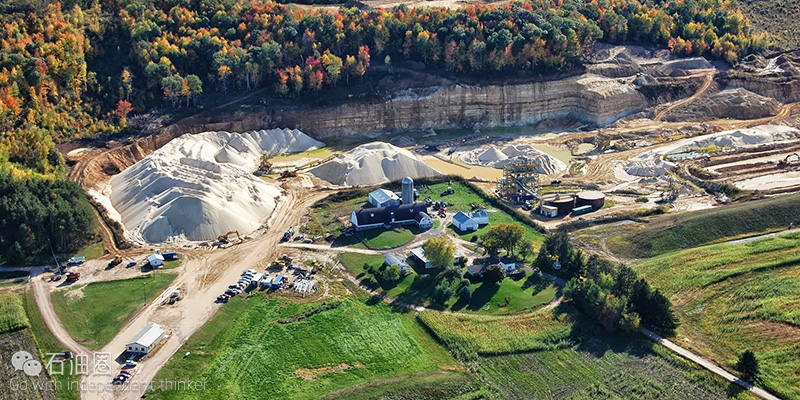Liberty Oilfield Services, a Denver-based hydraulic fracturing company, has three frac fleets operating in the Bakken, two in Colorado’s DJ Basin and three in the Permian Basin. “With ceramic proppant costing several times more than natural sand, almost all completions taking place in the Bakken today have migrated to northern white sand from Minnesota or Wisconsin – the highest quality silica sand you can get,” said Ron Gusek, VP Technology & Development at Liberty Oilfield Services.
Although natural sand will typically be crushed in wells more than 10,000 ft deep, Liberty has completed wells at such depths using northern white sand. The loss in conductivity has been offset by significantly increasing the amount of sand pumped into the well during the hydraulic fracturing process and through design changes to maximize contact area, according to the company. Some designs have also incorporated higher concentrations to optimize near-wellbore conductivity.
“We have found that, with the right engineering and a willingness to challenge the status quo, we can apply sand in environments that push the limits and still get a successful completion,” Mr Gusek said. By late 2016, the industry will have data illustrating how sand compares with ceramic proppant on an estimated ultimate recovery (EUR) basis. “Now we have wells completed with both ceramic and sand in relatively consistent geological settings,” he continued. “Once we get 12 to 18 months of production data from those wells, we can evaluate the decline curves and find out if the initial investment in ceramic really did provide a better well over the long term.”
Ceramics innovate through downturn
CARBO’s SCALEGUARD porous ceramic proppant is engineered with a controlled release technology to lengthen treatment life and reduce initial inhibitor washout.
While ceramic proppants continue to fill more technically demanding applications, fewer companies are choosing these higher-cost options for onshore wells. According to ProppantIQ, North American onshore demand for ceramic proppants fell from 3.4 billion lb in 2014 to approximately 1.1 billion lb in 2015. This year, it’s estimated that ceramic usage will drop to about 600 million lb. Despite this trend, technical innovations for ceramics are continuing, with CARBO developing a ceramic proppant that will inhibit scale buildup in fractures and even a proppant that can be traced inside the wellbore.
Operators commonly experience scale buildup in completions operations, when deposits such as barite or calcium begin to accumulate within the fracture, wellbore and surface production system. This typically results in a decrease in production. In most cases, an operator will periodically pump a preventive liquid scale inhibitor in an attempt to prevent these deposits at the fracture points or within the wellbore, but such methods bring mixed results. “If you have a horizontal well with 30 stages and you just start pumping chemicals down, it is not going to go in every stage,” said Terry Palisch, Director of Petroleum Engineering at CARBO. If scale buildup goes unchecked, production could become restricted and necessitate a workover operation.
SCALEGUARD, commercialized in 2015, is a ceramic proppant infused with scale-inhibiting chemicals that are designed to be released over the life of the well. It can be blended with any proppant based on the completion design, according to CARBO. “If you can inoculate the well from the fractures, you can stop scale not only in the perforations but you can prevent it in the wellbore and entire production system,” he said.
CARBO’s quantified propped reservoir volume imaging is expected to be launched in 2017. It is designed to allow the operator to detect and visualize proppant location at distances far-field from the wellbore after it is pumped.
This will be enabled by placing an electrically conductive ceramic proppant, which will then change the electric field. Before proppant is pumped, the company would transmit an electric current through a wireline inserted into the wellbore.
This would create an electrical field and allow the company to survey the field with an electromagnetic surface array. The detectable ceramic proppant is then pumped downhole, and another electromagnetic survey is performed. CARBO technologists then compare the before and after surveys to determine proppant position. “You develop what the electrical field looks like without the detectable proppant in it, and then you frac your zones,” Mr Palisch said. “Then you take the same survey and look at the difference between the two. Our analysis techniques will show where the proppant is located.”
The propped reservoir volume imaging service has been under development for more than five years, Mr Palisch said. In Q3 2015, the service was used in the last stage of a 16-stage 8,000-ft Permian horizontal well, and the operator was able to successfully determine where the proppant landed inside four perforation clusters in the stage, according to CARBO. Once deployed on a larger scale, this technology could help operators to better understand well and stage spacing, as well as how diversion material works to spread proppant throughout the wellbore. It would also help companies better target individual fracture points in a well, Mr Palisch said. “This is the first time in history we would be able to see where proppant is actually located at distances far-field from the wellbore.”


 石油圈
石油圈
